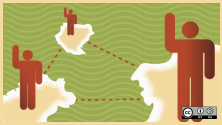A year-end review of Opensource.com’s top government stories underscores the observation of Red Hat's Mark Bohannon that the main question before governments today is not whether to use open source, but how. Several of the top articles indicate that this view can be applied to open data, as well.
The wind, as has been said for some time now, is at the back of open source. This is certainly true in the private sector, where adoption and deployments of open source continues to grow at a pace indicating that it's use has gone well beyond the "mainstream" threshold and is now being viewed as a central element of enterprise IT strategies.
In the government space, great progress has been made, as well, but more work needs to be done. In an April interview, Storming the Government Castle by Scott Nesbitt, current (Kathy Lee from Bonneville Power Administration) and former (Morgan Senkal, a former federal government employee and current development team lead at Metal Toad Media) government IT professionals explained that while government use of open source is strong and growing, lingering resistance remains due to inertia and red tape. Many veteran government IT professionals are more comfortable buying what they've known for years and are unwilling to take on new auditing requirements to prove compliance. These obstacles will likely be overcome with, among other things, the on-boarding of younger IT professionals, who are more familiar and comfortable with open source. A tougher problem, perhaps, is presented by limits on the ability of government IT workers to contribute to open source projects. Government workers, according to Lee and Senkal, "aren't allowed to work on things we don't have a work order for, so unless a project has been approved, we can't work on it during work time."
The U.S. federal government took action that will address some of these concerns when the Office of Management and Budget (OMB) in August released the U.S. Federal Source Code Policy. As explained in Mark Bohannon's article, U.S. government seeks reduced use of custom software, releases new policy to 'free the code', the policy promotes open source by improving "access to custom software code developed for the federal government." It is focused on "reducing reliance (and spending less money on) the development of custom software. And when custom software is used, the policy encourages steps to make it as widely reusable as possible by contributing back the code that was procured," said Bohannon. A key element of the policy is a three-year pilot program where the OMB directs each agency to release as open source software at least 20% of its new custom-developed code each year. Importantly, the policy also "encourages Federal employees and contractors to contribute back to the broader open source community by making contributions to existing open source projects," he said.
Considering open data, addressing the whether question was perhaps the easy part. The how question remains very much alive.
In his May article, Why open data matters today, Martin Yan points out the benefits of greater citizen engagement and involvement leading to a better sense of democratic empowerment. In business terms, products and services using government data could drive a global market valued annually at $3 to $5 trillion dollars, according to McKinsey. Martin called out the work that was being done by the Sunlight Foundation, a non-profit dedicated to making government more transparent and accountable, and some of the innovative online tools developed by their Sunlight Labs Team to facilitate citizen engagement.
However, in a subsequent article in November, Why keep Open States going?, James Turk reported that Sunlight Labs was closed in September because the Sunlight Foundation was struggling to determine its future in the face of a changed political and technological environment. This could be interpreted as an example of Sunlight struggling to address the how question.
Turk discusses the challenges of the Sunlight Foundation in the context his of work to help build and maintain the Open States project, which is "an effort to collect, and to some extent, standardize legislative information from all 50 states." Open States appears to have had more success on the how question. Turk cites their work being put to innovative and practical use by journalists and academics in different parts of the U.S.
In order to encourage the application of creative thinking to the how question on open data, Tim Nugent suggests making a game out of it in his piece, Open data as a game. Nugent describes his experience at Australia's GovHack AU, where he and his team have "made a game with the data: appliances, political responsibilities, elected officials' voting records, and news stories."
Why make a game out of open data? "People like games, but don't really understand data. If you can map the data to a game, people can learn about it without having to pore over reams of spreadsheets and XML documents. Making a game out of open data allows you take something useful, but inherently dull, and give it a fun skin. Essentially, making a game about open data is just a new way of visualizing the data," Nugent said.
He goes on to cite examples of creative games designed using different, seemingly banal data sets. The ultimate purpose is providing people with a new, refreshing and thought-provoking way of looking at data sets.
Government’s embrace of open source software and the public's embrace of government open data are undeniably real. As demonstrated, a reading of the best of the government channel of Opensource.com indicates that the true potential of both has yet to be fully realized. The potential, of course, is enormous and we all must maintain our focus on answering how.







Comments are closed.